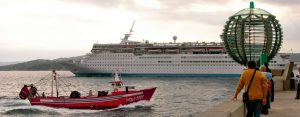THE
PORT

The surrounding Palamós was bought by King Pere II in 1277, who wanted to possess a strategic position north of Barcelona in the struggle for expansion and dominance taking place around the Mediterranean.
In 1279 the same King drew up a town charter for all those who wanted to live in the village, then known as “Palamors”.
Nowadays the port of Palamós is one of the main seaports in the province of Girona, and has a commercial dimension alongside fisheries, tourism and culture.
The Port of Palamós
The port of Palamós is situated between the Gran beach and the Palamós lighthouse. The port includes a marina, harbour and commercial sea port with nine piers, covering a total of 1,549 metres.
The port of Palamós is characterised by the coexistence of the commercial port with tourism and gastronomy, as it includes the fish market spaces together with the Fishing Museum (Museu de la Pesca) and the Fish Place (Espai del Peix).
- The Fishing Museum, housed in a former boat shed, which is the first museum dedicated to fishing around the Mediterranean. The museum also has fishing boats, real floating museums you can visit.
- L’Espai del Peix, a gastronomic experience that forms part of the Fishing Museum where you can learn how to identify, prepare and cook fish, from point of view to traditional seafood cuisine. There are courses, show-cooking, workshops and tastings of typical dishes.
- The Fish Marketplace, where you watch the fisch auction every evening from Monday to Friday with the local fishermen.
- The Fish Market is part of the Municipal Market, and every afternoon you can buy the products fresh off the boats of Palamós fishermen.
- Pescaturisme. Fishing tourism is a new activity that involves a day of fishing aboard boats leaving from the port of Palamós, giving tourists a unique, authentic experience. There are three different fishing tourism activities on offer:
Prawn fishing:
Prawn fishing allows tourists to fully participate in the fishing process and take part in reeling in the catch, all in the company of the ship’s crew. It is also a unique opportunity to learn from the expert knowledge of the ship’s captain, see how the crew works together, appreciate the changeability of the environment and the job… to become, in short, a prawn fisherman.
It is a long day filled with hard work, and should only be approached by people who want to undergo a unique experience.
Fishing and crayfishing
The trawl fleet is the largest in Palamós. Some of the fleet is dedicated to trawling for crayfish, a key product in Palamós markets, and a delicious ingredient with an incomparable flavour. This crustacean lives buried in the muddy bottom of the seabed. Trawling for crayfish requires skills that only a few fishermen possess.
This fishing tourism activity involves sharing a day aboard a fishing boat with crew as they fish for both crayfish and whitefish. The activity provides the opportunity to discover more about the species being caught, where and how to fish them, and what it means to be a fisherman today compared to the past, along with their traditions, stories and some anecdotes from a trade where doing the same thing every day is never the same.
Traditional fishing
The traditional fishermen in Palamós are very selective. They fish for highly-valued coastal species such as the blackberry rosefish, scorpionfish, cuttlefish, red mullet, and more. – Using traditional rigging, such as trammel nets, longlines and snoods. Fishing this way requires a certain expertise and a thorough understanding of the environment, often acquired over a lifetime and passed on from one generation to the next.
The fisherman respects the species being caught and knows all of its characteristics in detail, including where it lives or moves; always keeping in mind that fishing at sea should be a sustainable career.
And the reward for such dedication is to enjoy the sunrise from the open sea. It is a patient profession. Fishing tourism gives you the chance to understand the life of a fisherman, the knowledge gained over time, the years of experience, and respect for the sea.























